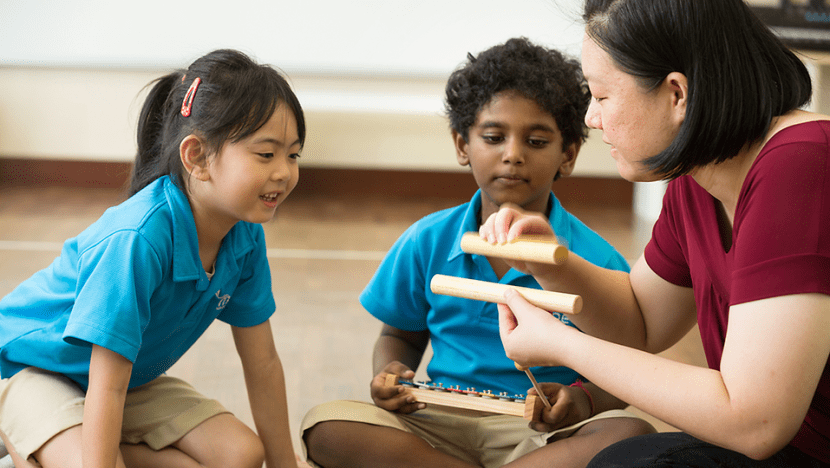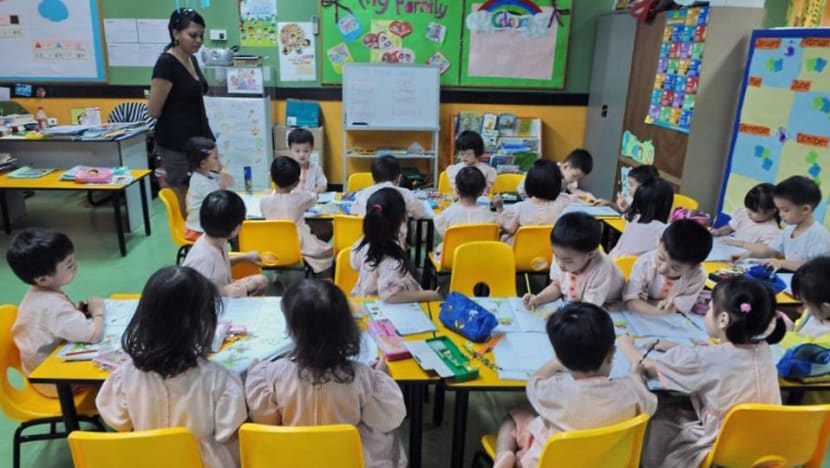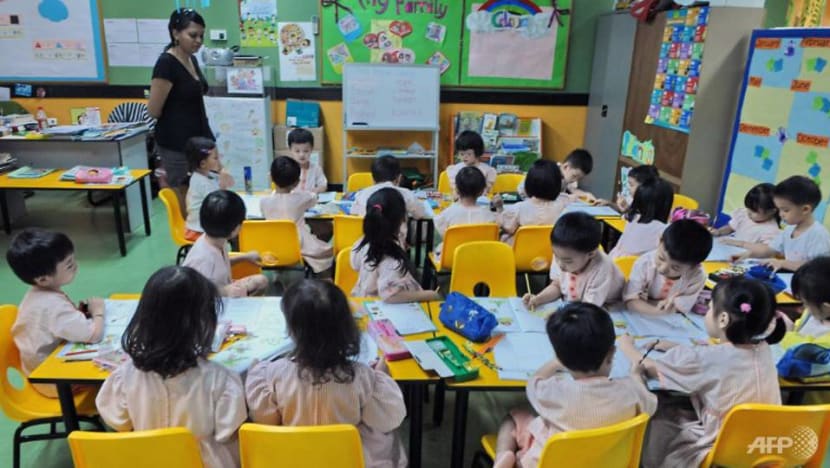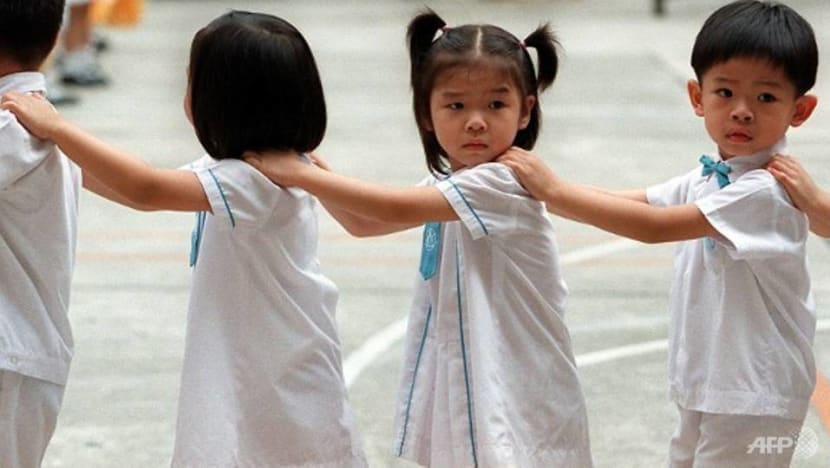commentary Commentary
Commentary: Long-neglected but now in the spotlight, Singapore’s pre-school sector
How can more families get access to high-quality, affordable childcare? Will recent moves to ramp up government-supported pre-schools crowd out private operators? SUSS’ Associate Professor Sirene Lim discusses the evolution of Singapore’s pre-school sector.

A teacher interacting with students at an MOE Kindergarten. (Photo: Ministry of Education)
SINGAPORE: Bill Gates once said that the leading indicator of where a nation is going to be in 20 years’ time is reflected in how well its education system is doing.
It is a pragmatic view of human potential as capital investment, and one that is reflective of Singapore’s journey.
CONTINUED COMMITMENT TO PRE-SCHOOL SECTOR
Singapore has been highly committed to investing in the development of its primary, secondary and post-secondary education system. It has been spending about 3 to 4 per cent of its annual GDP on education, amounting to about S$12 billion a year.
While increasing government spending on early childhood care and education (ECCE) to S$1 billion dollars annually is a fraction of what Singapore normally spends on its education system, the latest National Day Rally (NDR) nevertheless signals the Government’s continued commitment to the pre-school sector’s development even when it is an almost entirely privatised industry.
This announcement follows from the initial 2017 NDR, which was seen as a welcome spotlight on a long-neglected segment of the educational fraternity.
The ECCE sector has a part to play in nation and community-building, supporting child development, gender equality and an active workforce.
It is not made up of an association of childminders with qualifications, nor is it an industry providing pseudo-parenting services to cute young human beings.
READ: Commentary: Passion and patience insufficient qualities of an ideal pre-school teacher
ENSURING EQUITABLE ACCESS TO EARLY CHILDHOOD EDUCATION
Globally, an important priority for many governments is to ensure that every child has access to an inclusive and good-quality ECCE.
This has a lasting effect on children’s early brain development, holistic growth and learning potential, more than any other societal intervention that can be provided in their later lives.
This benefit is especially impactful for children growing up in vulnerable families and disadvantaged homes.

This year’s NDR has yet again signalled the Singapore Government’s continued commitment towards supporting lower-and-middle-income families’ access to such services through demand-side subsidies as well as increasing the proportion of government-supported services in a sector that has more than 1,800 childcare centres and kindergartens.
In most European and OECD member states, ECCE forms part of a mixed economy in which public programmes co-exist with private-for-profit and private-not-for-profit providers. Globally, the growth of the private-for-profit sector within such mixed markets has been rapid, becoming the default option in most low-and middle-income countries.
However, there is a possibility of increased social stratification and elite formation within such marketised systems, such as what’s been highlighted in reports comparing 27 EU countries.
An increase in private-for-profit ECCE provision poses risks to accessibility, affordability and possibly, even service quality depending on how government regulations are applied.
READ: Commentary: What a 21st century pre-school education looks like
READ:Commentary: The dangers of leaving our kids with a childcare centre or babysitter – how real are the risks?
Social stratification could be created when there is a plethora of corporatised childcare services and niche-programmes charging exorbitant fees.
Is there a risk of that happening in Singapore? On one hand, there is a cost disparity. The country’s median full-day childcare fees is at about S$850. At the higher end of the range, centres charge more than S$2,000 per month.

In Germany, however, where the ECCE market is dominated by not-for-profits, it is parent-run establishments that most likely contributed to social stratification and elite formation.
A similar trend has not been reported in Singapore. Families here still have the option of home-schooling their pre-schoolers and sending their children to faith-based settings, which are usually more affordable.
GOVERNMENT INTERVENTION OVER THE YEARS
Many OECD governments typically intervene given concerns in two areas: First, when levels of inequality among citizens become a threat to social cohesion and the nation’s equity goals.
Second, when mothers cannot access the labour market easily because there is a lack of childcare in the family and community, and this becomes an inefficient waste of resources (given women’s education and potential labour contribution).
Government interventions usually take a few forms: Regulation, the provision of demand-side (family) subsidies, supply-side grants or price controls, and the government’s direct provision of ECCE.
The increasing family subsidies, setting up of MOE Kindergartens in selected sites, the Anchor Operator (AOP) and Partner Operator (POP) schemes are all examples of how Singapore’s ECCE market is being steered to ensure greater accessibility and affordability of services.

Up until 2014, the ECCE industry has been entirely private-for-profit or not-for-profit. To date, there are now 24 MOE (public) kindergartens in a landscape of 1,800 plus childcare centres and kindergartens.
Even then, about half of the remaining privately-run sector are in the AOP and POP schemes receiving government grants. They are obligated to maintain affordable fees, monitor quality and be located in accessible sites.
Programmes such as KidSTART are also resource-efficient way to support at-risk groups of children and their caregivers at a time when it matters most.
FOCUS ON DEVELOPING THE PROFESSION
As a nation that relies on the quality of its human resource and societal cohesion, we must forge ahead to build quality ECCE services. This requires a strong, knowledge-driven profession that will advocate for children’s best interests – physical, emotional and cognitive.
The business of educating young ones must be provided by thinking professionals who are responsive to young children’s unpredictable curiosity and enthusiasm, and can develop their unique capabilities and motivation to learn.
But this aim is less of a priority compared to other national objectives, including providing access.
In 2013, Germany introduced reforms guaranteeing a place in childcare for every child aged 1 and above.
READ: Commentary: In pre-school boost, parents are the missing critical players

Its purpose was to influence peoples’ decision to have children in a rapidly ageing society and tackle the nation’s long-term demographic change. While welcomed by some, this policy move has also raised many questions about the realistic possibility of providing high-quality childcare for every child.
FOCUS ON THE LONGER-TERM HUMAN CAPITAL ASPECTS
There are two ways to look at the purpose of ECCE within any nation – a more short-sighted view is to create such services so as to meet the practical needs of working adults by providing custodial care.
A longer-term view of ECCE is to go beyond meeting families’ logistical needs, to be part of the “whole village” that raises children for a better society, where professionals work together with parents to support children’s learning and development, not simply for primary school.
READ: Commentary: Hong Kong and Shenzhen showed us what quality early childhood education looks like
American studies have shown that poor quality childcare can have harmful effects on their social and emotional development.
The UK’s large scale, longitudinal Effective Provision of Pre-school Education study has shown that children who attend low-quality pre-schools receive little to no added benefit in terms of socio-emotional and cognitive development and may be less resilient in the face of negative encounters in primary and secondary school.
In contrast, the developmental benefits of high-quality programmes can have lasting effects on children even beyond secondary school.
WHAT QUALITY ECCE LOOKS LIKE
Quality provision is characterised by the warm and supportive relationships that teachers and children have, their sustained conversations through enriched and authentic play and learning experiences.

High-quality pre-school classrooms have a distinct mark of intellectual curiosity and keen inquiry that is shared by both children and teachers, and do not resemble a watered-down primary school curriculum with its typically disconnected subject disciplines.
In any ECCE system, it would be presumptuous to assume correlation between quality and fees or other structural factors such as group size, adult-child ratio and teachers’ qualifications.
Instead, it has been found that quality ECCE is dependent on the competencies and everyday decision-making of leaders and staff within each centre, whose actions and words directly determine the experience children have within a given site.
The last time that Singapore’s ECCE was compared with other nations was in the EIU’s Starting Well report in 2012, in which Singapore ranked 29 overall out of 45 countries (30 for the quality indicator and 21 for affordability).
Singapore has chosen to respond by providing stronger support to pre-schools in their quality improvement efforts, and applying a more developmental and less punitive approach.
Since that report, one in two ECCE centres have been quality rated by ECDA’s quality assurance assessors under the Singapore Pre-school Accreditation Framework (SPARK) even though it is not mandatory.
Centres are rated on a scale of 1 to 6 (rated “emerging”, “performing”, or “mastering”) in five areas across more than 40 indicators, and as long as centres obtain an “emerging” score, they receive SPARK-certification. SPARK-certified centres are to undergo quality rating every few years while they continue to use the rating instrument for in-house self-evaluation.
Quality ECCE cannot be bought. It requires a profession to attract capable, sincere people who can be retained.
And over time, these professionals must be supported as critically reflective practitioners who will develop quality ECCE practices grounded in contemporary theories and research-based knowledge about how young children grow and learn.
Associate Professor Sirene Lim is Academic Lead for the Early Childhood Education Programme at the Singapore University of Social Sciences.














